Related Research Articles
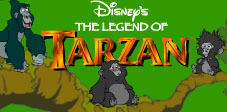
The Legend of Tarzan is an American animatedtelevision series produced by Walt Disney Television Animation, based on Tarzan from the novels written by Edgar Rice Burroughs, the character's original creator who appears in one episode of the series. The series is also based on Disney's 1999 animated feature film Tarzan by Walt Disney Pictures and aired initially on the Disney's One Too block on UPN. However, reruns were broadcast shortly after on Toon Disney.
Opar is a fictional lost city in the Tarzan novels of Edgar Rice Burroughs and later the Khokarsa novels of Philip José Farmer and Christopher Paul Carey, as well as various derivative works in other media.
Mangani is the name of a fictional species of great apes in the Tarzan novels of Edgar Rice Burroughs, and of the invented language used by these apes. In the invented language, Mangani is the apes' word for their own kind, although the term is also applied to humans. The Mangani are represented as the apes who foster and raise Tarzan.

La is a character in Edgar Rice Burroughs's series of Tarzan novels, the queen and high priestess of Opar, a lost city in the jungles of Africa.Opar is portrayed as a surviving colony of ancient Atlantis in which incredible riches have been stockpiled down through the ages. The city's population exhibits extreme sexual dimorphism caused by a combination of excessive inbreeding, cross-breeding with apes, and selective culling of offspring. Consequently, female Oparians are physically perfect, while male Oparians are hideous bestial creatures.

Tarzan the Untamed is a book by American writer Edgar Rice Burroughs, the seventh in his series of twenty-four books about the title character Tarzan. It was originally published as two separate stories serialized in different pulp magazines; "Tarzan the Untamed" in Redbook from March to August, 1919, and "Tarzan and the Valley of Luna" in All-Story Weekly from March to April 1920. The two stories were combined under the title of the first in the first book edition, published in 1920 by A. C. McClurg. In order of writing, the book follows Jungle Tales of Tarzan, a collection of short stories about the ape-man's youth. Chronologically, it follows Tarzan and the Jewels of Opar.

The Return of Tarzan is a novel by American writer Edgar Rice Burroughs, the second in his series of twenty-four books about the title character Tarzan. The story was first published in the pulp magazine New Story Magazine in the issues for June through December 1913; the first book edition was published in 1915 by A. C. McClurg.

Tarzan and the Ant Men is a novel by American writer Edgar Rice Burroughs, the tenth in his series of twenty-four books about the jungle hero Tarzan. It was first published as a seven-part serial in the magazine Argosy All-Story Weekly for February 2, 9, 16 and 23 and March 1, 8 and 15, 1924. The story was first published in book form in hardcover by A. C. McClurg in September 1924. It was also adapted for Gold Key Comics in Tarzan #174-175 (1968).

The Beasts of Tarzan is a novel by American writer Edgar Rice Burroughs, the third in his series of twenty-four books about the title character Tarzan. Originally serialized in All-Story Cavalier magazine in 1914, the novel was first published in book form by A. C. McClurg in 1916.
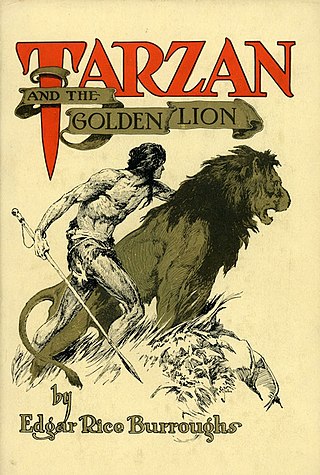
Tarzan and the Golden Lion is an adventure novel by American writer Edgar Rice Burroughs, the ninth in his series of twenty-four books about the title character Tarzan. The story was first published as a seven part serial in Argosy All-Story Weekly beginning in December 1922; and then as a complete novel by A.C. McClurg & Co. on March 24, 1923.
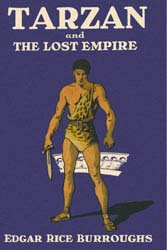
Tarzan and the Lost Empire is a novel by American writer Edgar Rice Burroughs, the twelfth in his series of twenty-four books about the title character Tarzan. The story was first published as a serial in Blue Book Magazine from October 1928 through February 1929; it first appeared in book form in a hardcover edition from Metropolitan Newspaper Services in September 1929. This was the first Edgar Rice Burroughs book not published by A. C. McClurg, with whom Burroughs had cut off business ties due to a dispute over royalties.
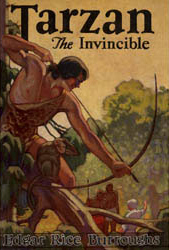
Tarzan the Invincible is a novel by American writer Edgar Rice Burroughs, the fourteenth in his series of twenty-four books about the title character Tarzan. The novel was originally serialized in the magazine Blue Book from October, 1930 through April, 1931 as Tarzan, Guard of the Jungle.

Tarzan Triumphant is a novel by American writer Edgar Rice Burroughs, the fifteenth in his series of twenty-four books about the title character Tarzan. The novel was originally serialized in the magazine Blue Book from October, 1931 through March 1932. It should not be confused with the 1943 film Tarzan Triumphs, as the plots are not related.

Tarzan's Quest is a novel by American writer Edgar Rice Burroughs, the nineteenth in his series of twenty-four books about the title character Tarzan. Originally serialized in six parts, as Tarzan and the Immortal Men, in The Blue Book Magazine, from October 1935 to March 1936; the first collected edition was published as the 1936 novel Tarzan’s Quest by Burroughs’ own publishing company.

Tarzan the Magnificent is a book by American writer Edgar Rice Burroughs, the twenty-first in his series of twenty-four books about the title character Tarzan. It was originally published as two separate stories serialized in different pulp magazines; "Tarzan and the Magic Men" in Argosy from September to October, 1936, and "Tarzan and the Elephant Men" in Blue Book from November 1937 to January 1938. The two stories were combined under the title Tarzan the Magnificent in the first book edition, published in 1939 by Edgar Rice Burroughs, Inc.
Muviro, chief of the Waziri, is a character in the Tarzan saga created by Edgar Rice Burroughs.

Tarzan the Tiger (1929) is a Universal movie serial based on the novel Tarzan and the Jewels of Opar by Edgar Rice Burroughs. It stars Frank Merrill as Tarzan, Natalie Kingston as Jane, and Al Ferguson. It was directed by Henry MacRae.

Tarzan is a fictional character, a feral child raised in the African jungle by the Mangani great apes; he later experiences civilization, only to reject it and return to the wild as a heroic adventurer.
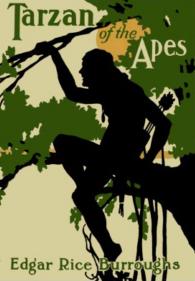
Tarzan is a series of 24 adventure novels written by Edgar Rice Burroughs (1875–1950) and published between 1912 and 1966, followed by several novels either co-written by Burroughs, or officially authorized by his estate. There are also two works written by Burroughs especially for children that are not considered part of the main series.

The Legend of Tarzan is a 2016 adventure film directed by David Yates. Based on the character Tarzan created by Edgar Rice Burroughs, the film stars Alexander Skarsgård, Samuel L. Jackson, Margot Robbie, Djimon Hounsou, Jim Broadbent, and Christoph Waltz. The story follows John Clayton (Tarzan), who, after moving to London, is convinced by George Washington Williams to return to his former home in the jungles of Africa, to investigate claims of slavery. It is the final film to be produced by Jerry Weintraub before his death in 2015.
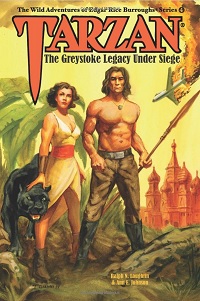
Tarzan: the Greystoke Legacy Under Siege is a novel written by Ralph N. Laughlin and Ann E. Johnson featuring Edgar Rice Burroughs's jungle hero Tarzan. It is the fourth volume in The Wild Adventures of Tarzan, a series of new works authorized and licensed by Edgar Rice Burroughs, Inc. It was first published by Edgar Rice Burroughs, Inc. in May 2017 in trade paperback, with a hardcover edition following in June of the same year.
References
- ↑ Adams, David Arthur. "Some Thoughts About The Return of Tarzan" in ERBzine Magazine #0666
- ↑ The Return of Tarzan chapter 14.
- ↑ Tarzan Alive page 89.
- ↑ Gone primitive page 57.
- ↑ Burroughs, Edgar Rice. Tarzan and the Golden Lion Archived 2003-08-31 at the Wayback Machine , chapter 5
- ↑ Burroughs, Edgar Rice. Tarzan and the Lost Empire, chapter 1: "'Something is coming, Bwana,' said Muviro, sub-chief of the Waziri."
- ↑ Michael Tomasello, A natural history of Human Morality, Harvard University Press, p.90
- ↑ Edgar Rice Burroughs’s Tarzan – myth and/or critique? A chapter in Africa and Europe: En/Countering Myths. Essays on Literature and Cultural Politics. Ed. Carlotta von Maltzan. Peter Lang Publishers, Frankfurt am Main and New York, 2003, pp.65-76
- ↑ Vivanco, Luis; Gordon, Robert J. (2006-08-01). Tarzan Was an Eco-tourist: ...and Other Tales in the Anthropology of Adventure. Berghahn Books. p. 65. ISBN 978-1-78238-195-2.
- ↑ Torgovnick, Marianna (1990). Gone Primitive: Savage Intellects, Modern Lives. University of Chicago Press. pp. 56–57. ISBN 978-0-226-80832-1.